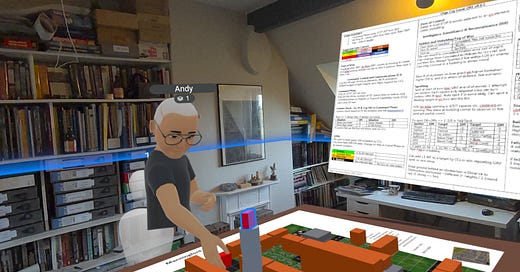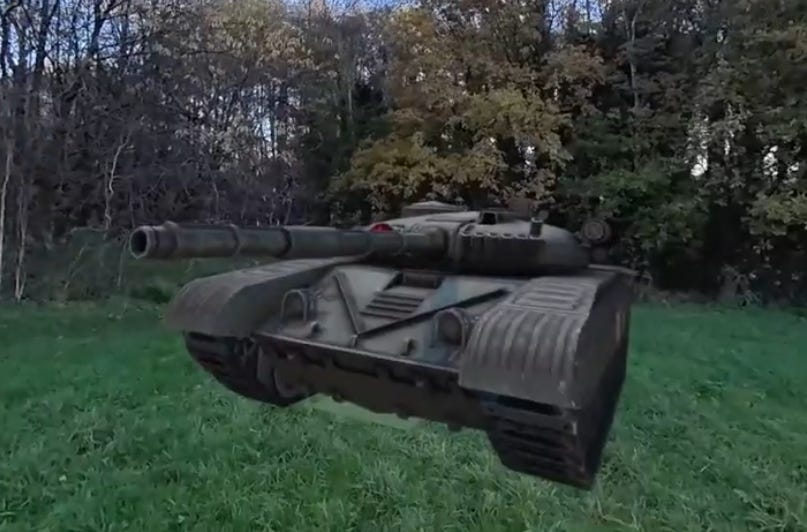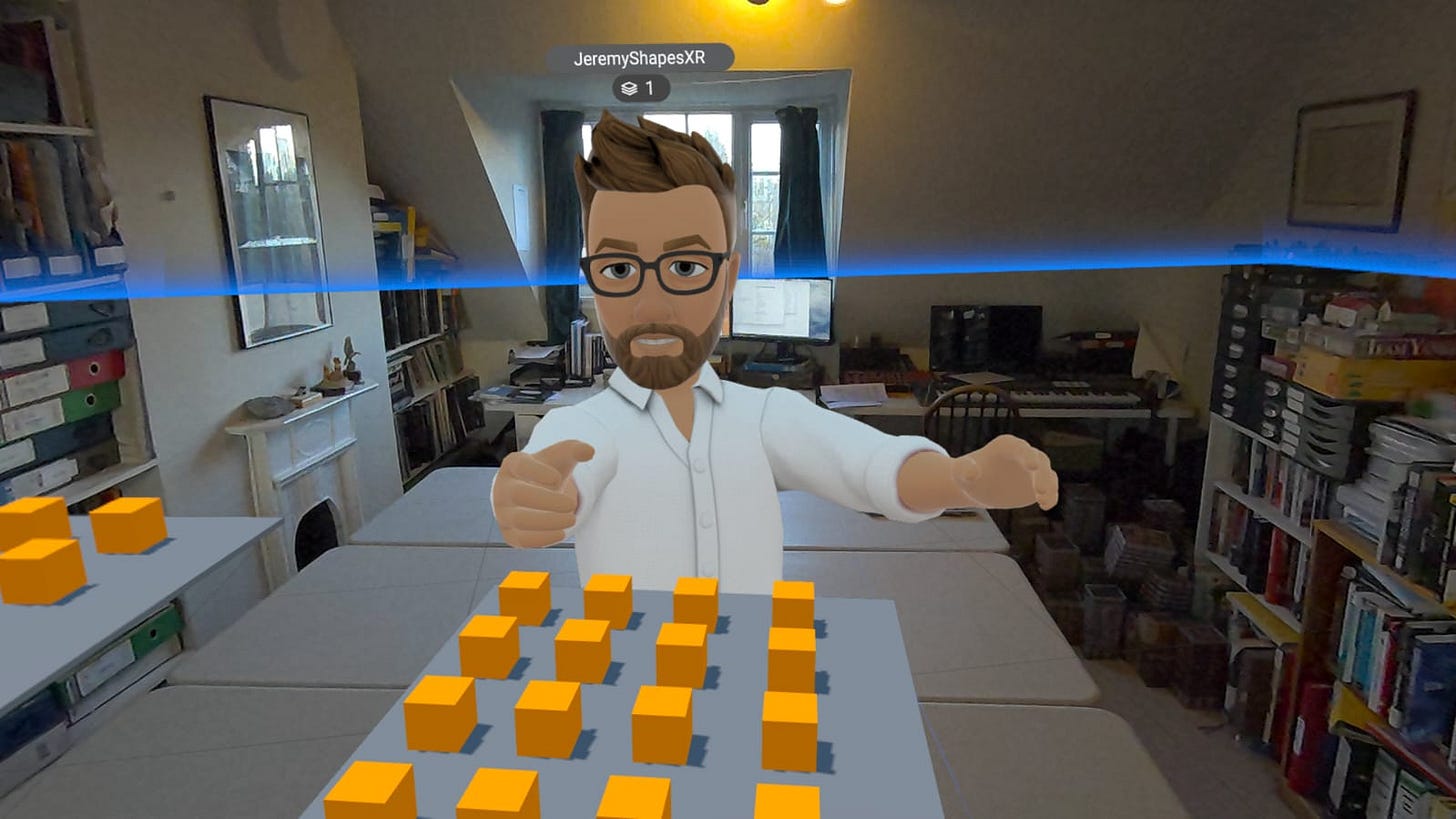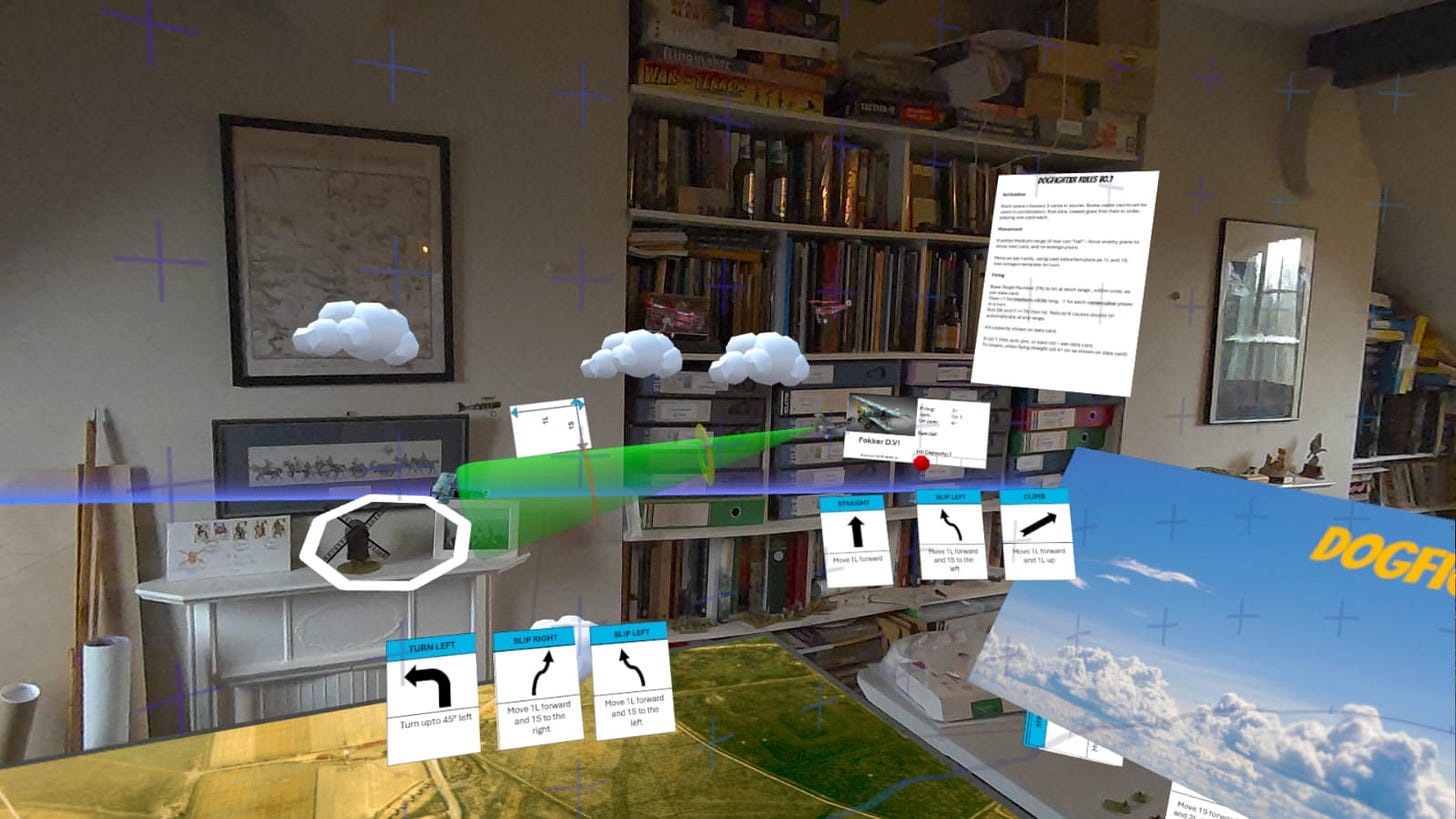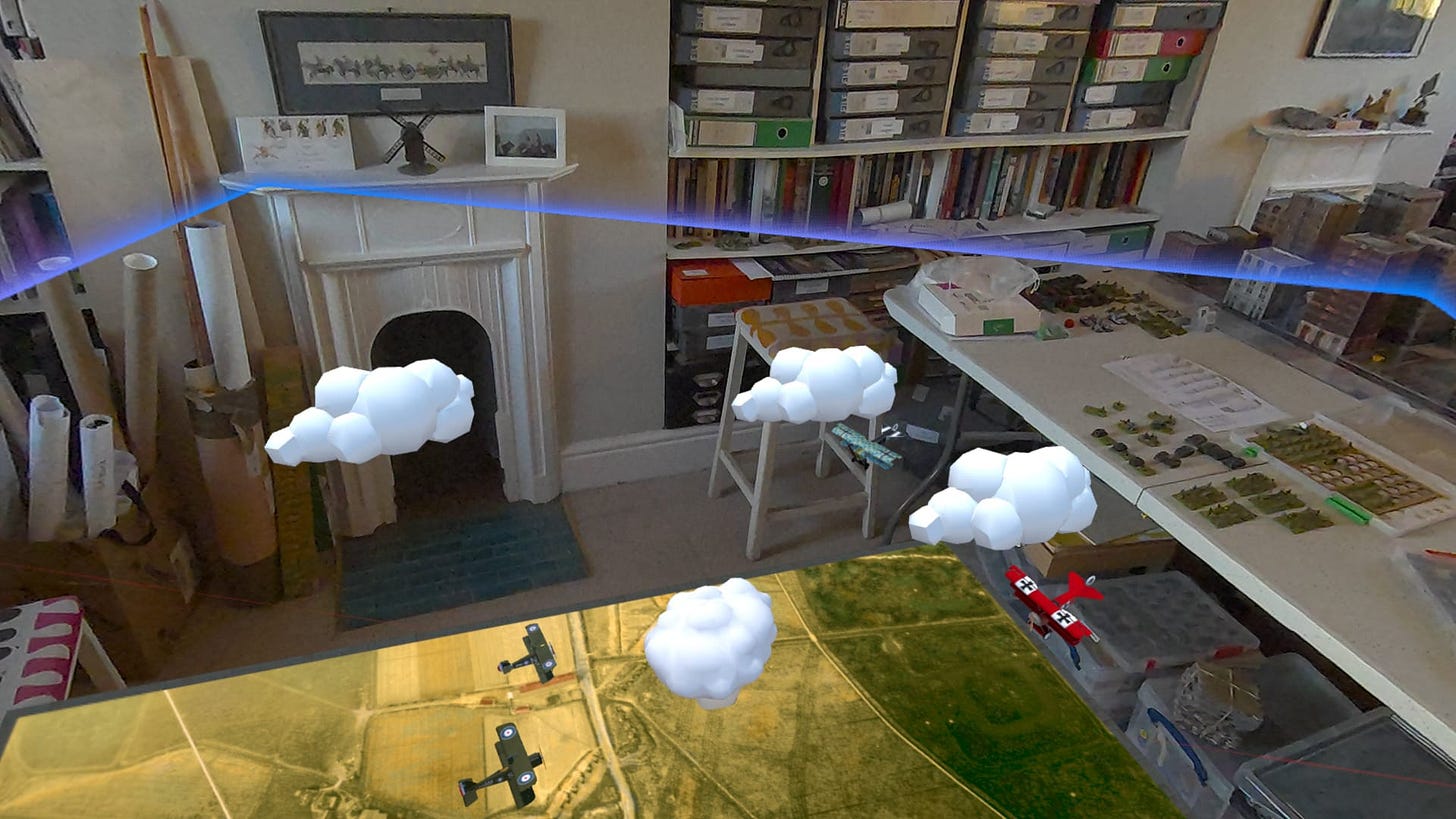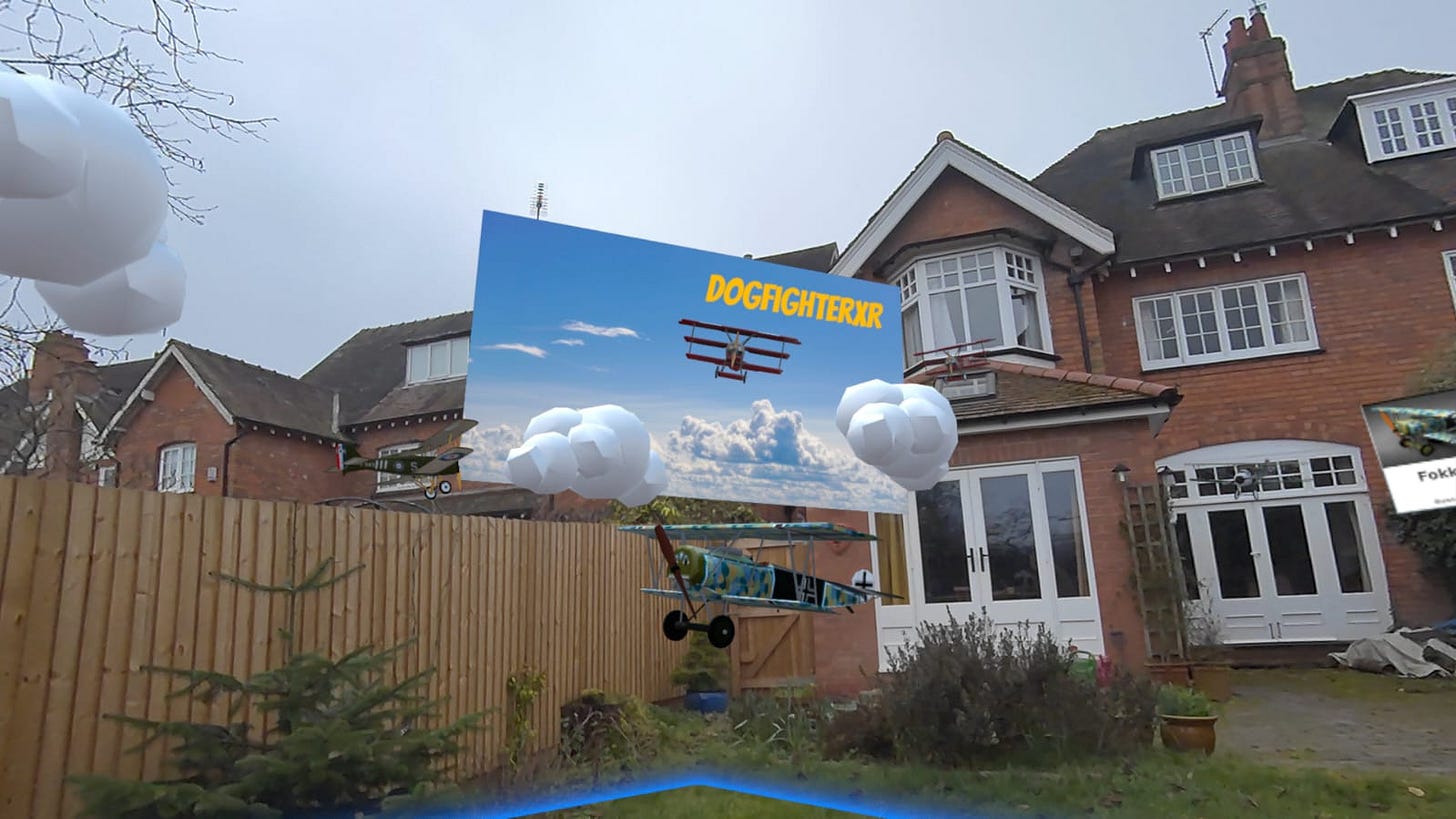Mixed Reality Wargaming
I’ve long been interested in the idea of playing wargames within virtual spaces. Here’s a space I built in Unity as a demonstrator back in the 2010s, but although it had the key elements (being able to place assets and move them in a collaborative environment), I never progressed it to a full game.

My current Virtual Reality (VR) platform of choice is Frame which allows both for in-world building and both mobile/desktop and headset access via a browser (so no need to download anything). Again I’ve got a prototype of a games room there, but not yet finished it to the point of having a playable game.

The idea of doing this in Mixed Reality (MR) (where the game is overlayed on the physical space around you, rather than existing in a purely imagined space as in Virtual Reality) was also appealing, and I briefly had a TiltFive lookalike which involved looking at a surface through a split-mirror which would overlay the virtual data. Microsoft Hololens was underwhelming in the extreme (mainly narrow field of view) and Magic Leap even worse (OK in a darkened room, and more FOV issues). Then along came the Quest 3, which used cameras on the front of the headset to capture the real world space and show that to you in the headset, but overlayed with digital assets and Mixed Reality was suddenly there and usable and affordable.

Tabletop Simulator
My interest in MR (and VR) wargaming is partly driven by a frustration with platforms such as Tabletop Simulator (TTS). I love the 3D nature of the game board (and hence prefer TTS to Roll20 or Vassal), and I actively don’t want too much of the game mechanism to be dictated by code - I want it to feel like a tabletop game and to let me change things on the fly. But TTS seems (and is literally) a very disembodied experience, you have the players voices, and maybe an icon pic, but nothing more. And camera control is a real pain.
To me the promise of MR wargaming is that I can just lay a game out in MR on my empty table (or indeed on the floor or anywhere in the room - even above a manual game in progress), invite my friends and colleagues into the space, see them as avatars, and they see me as an avatar in their own offices or game rooms, and then we just play. And I think I’ve finally got to that point.
Arkio
As suggested above the only core requirements for an MR system are being able to import assets (actually only needs to be 2D assets such as maps, counters and player aids), place them in the world, bring in your friends/colleagues, and all of you being able to move the pieces.
I thought initially I had got there with Arkio. Arkio is an MR app designed for architects, letting them import models, place them on a virtual table, discuss, annotate and change them, and even teleport “down” to ground level to get a VR, pedestrians, view of the build. Arkio also works well outdoors, allowing builds to be visualised in-situ.
It didn’t take me long to bring some pieces into an Arkio build and move them around, and even build my own game board, based on my Cityfight2024 game.
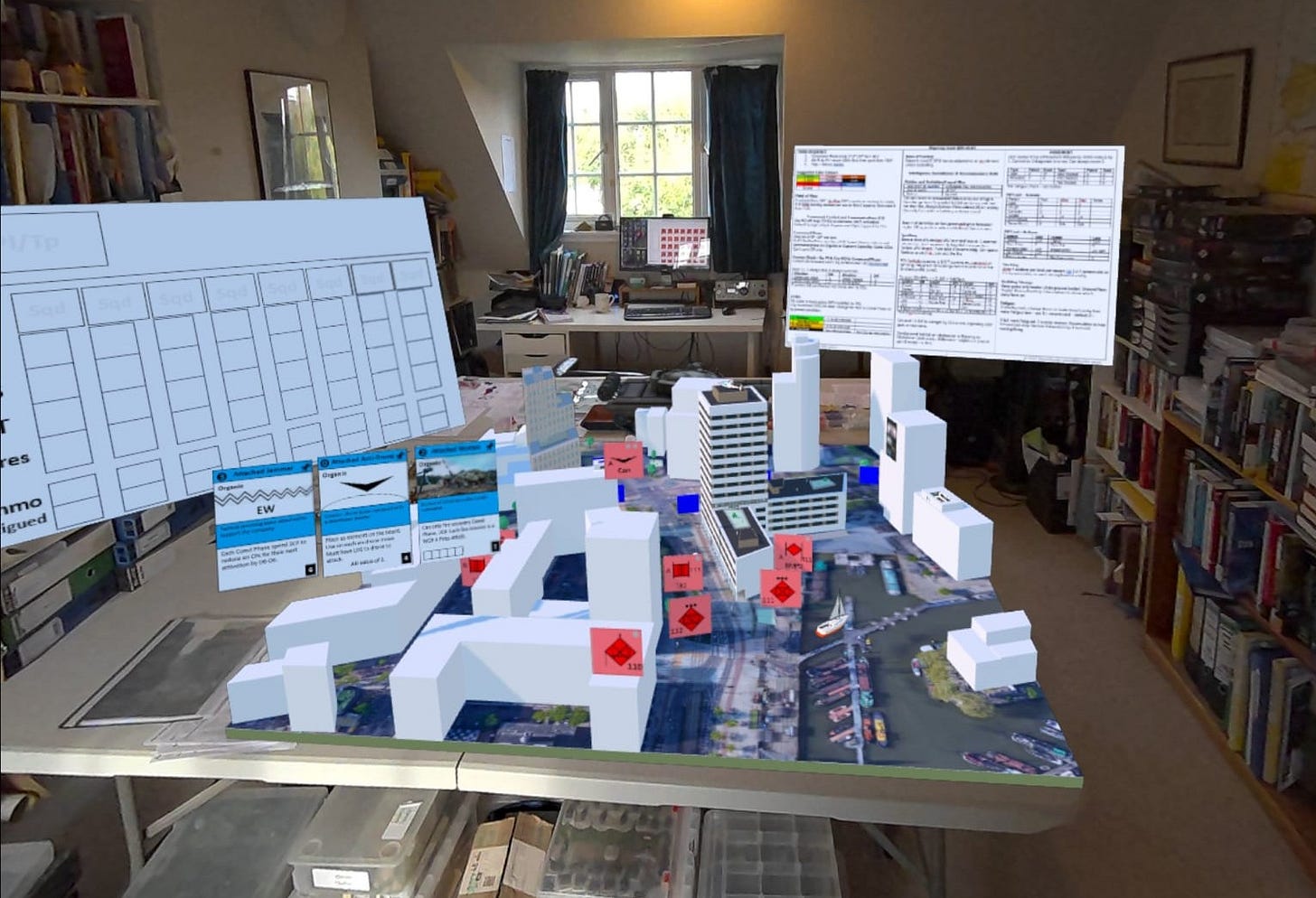
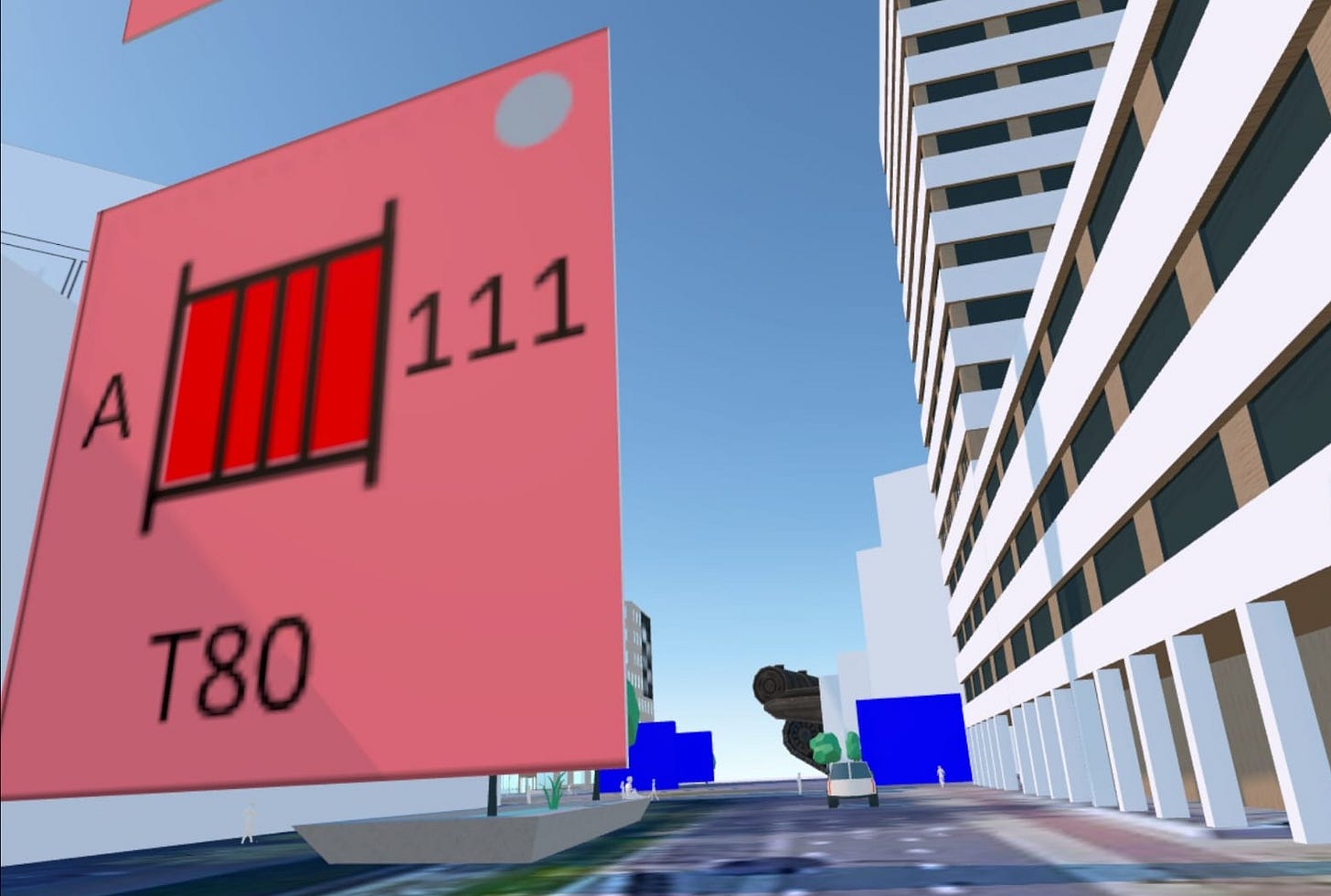
Arkio also highlighted one of the ongoing issues with working in 3D spaces - there is no agreement about the scale of 3D objects. So if you download an object from a 3D model warehouse site such as Turbosquid or Sketchfab you’ve no idea what size it will be in your world. I once brought a bathroom tap (faucet) in for a work project that was the size of the house I wanted to put it in. This time I bought a nice T72 model thinking it would look great on the Arkio city streets - but it was life-sized and filled my wargames room completely - I was even ducking under the (virtual) barrel as I moved around! Of course you can rescale it easily - but its still a shock when it first comes in, and probably means its over-detailed for game use.
The upside of the life-sized model was that I could take it down to the local woods to get some good photos (and no doubt attract curious looks from passers-by as I leapt around an empty space with my Oculus headset on!)
However, I didn’t find the Arkio object manipulation particularly intuitive, and trying to invite someone else in seemed to need everyone to have paid accounts, and even trying to juggle my Arkio account between the PC and Quest seemed problematic. So was there a better app out there?
ShapesXR
On my latest trawl through the new apps on the Quest last month I spotted ShapesXR. I downloaded it, went through the tutorial and was soon bringing game assets in and placing them on the virtual table. Pretty soon I got to where I had been with Arkio, but had some questions and a few small issues with the UI and how the world worked. ShapesXR reached out to me as a new account, and a few days later I was joined by a Jeremy from ShapesXR in-world, who took me through how to get the best out of the platform. This was the first time I’d been in MR with someone else - Jeremy’s avatar was in my room, showing me how to manipulate virtual objects in my room, and we were passing objects backwards and forwards between the two of us. Yes the avatars are a bit cartoony (they use the standard Quest avatar that you set up in Meta Horizons), but look past that and, within the agency afforded by the application, the person is in the room with you. There is spatial audio and even lip-sync to add to the immersion.
Armed with new knowledge I started to really think about what I wanted to build. An urban wargame had always been an obvious choice as a) it’s what my PhD is on, and b) it is inherently 3 dimensional - something which traditional physical manual games struggle to replicate - unless you go all out with miniatures, scenery and constrained viewpoints as with my Vertical Urban Wargame. But a chance discussion on something else entirely on our PhD Discord had me thinking about a spaceship/starfighter wargame, again inherently 3 dimensional and not really captured by games such as X-Wing. I soon had some models imported from Sketchfab and started trying out ideas for elements like shooting ranges, movement templates, shields, and even asteroids to hide behind.
One of the real “ooh ah” moments was just bringing in the spaceship models. Quite apart from the scale issues described above there have always been issues with importing 3D objects into applications as you need files for geometry (the shape), texture (the colours) and even things like bump maps and specular/normal maps. Standards such as .obj and .fbx have been OK, but still fail as often as not to work without extra effort in my experience. But the last few years have seen the emergence of a new standard, glTF. This, particularly in its binary, single file, form of .glb seems to have solved the 3D model import problem (apart from scale!). Every model, except one, that I’ve downloaded in the last week or so from Sketchfab as .glb has imported seamlessly into SpacesXR - and all these models were free!
One downside of a space game is that I really wanted to use vector movement in order to make it more “realistic” (Traveller’s Brilliant Lances anyone?), but that would make it more complicated, and not ideal for a demo game. So if “cinematic” or “aerodynamic” movement would be a preferable why not go back to the source - a World War 1 dogfight?
DogfighterXR
My first experience with a manual WW1 dogfighting wargame dates back to the 1970s and an Airfix magasine article on using 4ft dowels and universal joints to build a dogfighting game that really existed in a 3D space (an earlier example of the same approach is described in Donald Featherstone’s Air War Games). It was great fun, but the dowels were prone to tipping over - and smashing the fragile 1/72nd scale aircraft to bits! In recent years, Wings of War (now Wings of Glory) has become the go-to WW1 dogfighting game. You play with models which are about 6-10cm wingspan on small bases, and then choose 3 cards to represent their orders for the next 3 moves. Each player reveals their cards one at a time, and all movement is measured using the cards themselves. The trick is to try and guess what cards your opponent is going to play, as otherwise the aircraft are soon flying away from each other! Altitude is ignored in the basic game, and in the advanced game is represented by inserting extra pegs into the stand to lift the aircraft up, but only by a centimeter or so - so nowhere near to scale. The X-Wing game mentioned above is effectively a derivative of Wings of War.

It didn’t take me long to sort 1 page of rules and a new set of cards for a Mixed Reality game in the style of Wings of War - a game I’ve christened DogfighterXR. Being in a 3D space I need make no abstractions in terms of how I handle altitude, it’s just another set of cards with details of how to do a shallow, normal or steep dives or climbs. Distance measurement (in the horizontal and vertical) uses Short and Long sides of cards (thought the original WoW did that, but it’s not in my rule book). I’m not, at the moment, differentiating between aircraft types for rate of turn so there’s a simple octagon play aid to make turns. A cone was readily made in-world to show the range and arc of fire, with extra bands to show short/medium/long range. Rez a few clouds, import some very nice model aircraft from Sketchfab and the game was good to go.
Each player can independently scale the game as they require, so I could go from tabletop to floor game in my games room, and then really expand it to a lawn game when I moved outside.
One problem I found was that whilst in MR I could readily pick up a dice and roll it, if it landed on an area covered by the “ground” image it disappeared! Also one of the big advantages of MR was that I could play anywhere, so there may not be a table to roll a dice on, or even a dice within reach. ShapesXR has currently got physics (unlike Frame) so I couldn’t just have a virtual dice to roll, and it also hasn’t got scripting yet so I couldn’t press a button for a random dice roll. The trick I realised was to use ChatGPT on my phone in hands-free mode. If I want to roll the dice I just say “roll a D6” and it gets rolled and the result spoken out to me. This opens up a whole range of possibilities as I can now develop a custom GPT to be a “player aide” for DogfighterXR (and other MR games I make), which will not only roll dice but also help with dice modifiers, unit stats and other game information.
Multi-Player Games
Having a solo game was nice, but the key point of all this is to have multi (>1) player games, with distributed players. Andy Fawkes and I have just put the manuscript of our book on The Military Metaverse to bed, so who better to try the mechanics and practicalities out on? Andy hadn’t used ShapesXR but downloaded the app to his Quest, put the Quest on, went through the starter tutorial and then I read out the 6 character code for my ShapesXR space, over a Zoom call. He typed that in using his virtual keyboard - and his avatar appeared in my room and we killed the Zoom call. He soon had the hang of picking up the game objects, rezzing his own objects, and grabbing the whole world so as to resize it to fit his environment. Initially he started in VR mode, but eventually found the MR toggle, so that he saw my virtual “game table” in his own office.
Andy particularly liked the way that he could scale, rotate and place the shared environment wherever he wanted in his own physical spaces, so at one point he had it shrunk down and sat on his lap. He also used the scaling so that he could experience any build at eye-level/subjective mode, or loom over it in a more objective/god mode.
All in all, for a first try it all worked very nicely.
Next Steps
The next step is to try and actually play a full game of DogfighterXR with someone. Unfortunately the overlap between manual wargamers and Oculus Quest 3 owners seems to be a pretty narrow one, but I’ve put out calls on Fight Club, Bluesky, LinkedIn and a couple of other lists. Failing that I might try the ShapesXR Discord or even a Facebook group. If you want to have a go just drop me a line and we can test it out for “real”.
In parallel with DogfighterXR I’m creating a simple set of rules for a contemporary urban XR game, with roughly a platoon-sized force on each side, and maybe even the odd drone.
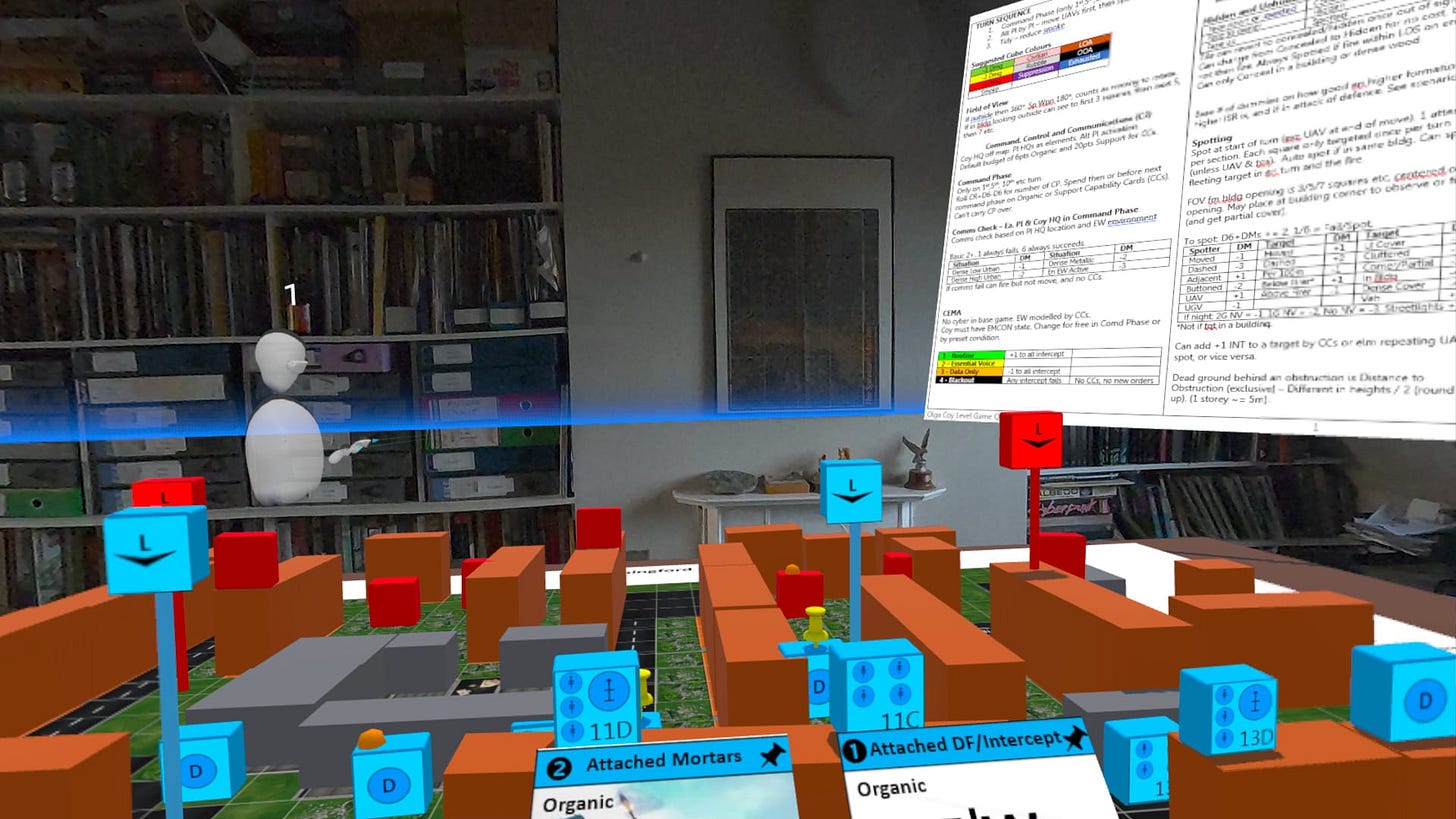
I’ll report back as each of these progresses. I’m also still tempted to do the vector movement space game, and maybe even take a simple land wargame such as Bob Corderey’s Portable Wargame or Hexblitz and put that into XR. The aim is to have some of these games ready and playable for the summer professional wargames conference circuit - in particular COW, DSET and ConnectionsUK.
Why Mixed Reality Wargaming
To end with, let’s just restate why I think Mixed Reality wargaming should be of interest. Bear in mind though that a) face-to-face manual wargaming is still probably the “gold standard” and I’ve no wish to replace that and b) ignore what the avatars currently look like, in a few years they may look no different to a physical person in front of you.
The advantages of this sort of mixed reality wargaming are, to me, that:
You can create wargames which deal naturally with the third dimension, without having to use simplistic abstractions or having to store, carry around and lay out loads of 3D terrain, or deploy Heath-Robinson contraptions;
It creates (certainly for me) a better and more engaging experience for remote game play than non-embodied platforms such as Tabletop Simulator. The interaction with the game and with each other is very natural. For instance you don’t have to try and work out where their cursor is, you just look at what they are pointing at (and we all know how important good pointing is to wargaming!);
Tied to the above, I suspect that it may be easier and more enjoyable to prototype games in XR than in TTS. The lack of some TTS widgets (e.g. card decks, dice/counter bags) might make things a bit cumbersome at present, but I’m sure such features will come. In fact I’d be amazed if at some point in the future there isn’t an MR/XR mode for TTS.
And of course XR gaming shares with TTS and other digital gaming platforms the fact that you can play a game anywhere, at any time, and with people drawn from anywhere in the world.
These are all just baby steps towards MR/XR gaming. ShapesXR is not designed for this, I’m just leveraging its general purpose abilities in order to wargame with it. If a market for this does emerge then we can expect to see dedicated platforms with all the bells and whistles that TTS, Roll20, and even Vassal have. Until then, I’m all for experimenting, seeing what works and what doesn’t, and helping to find out if there really is a valid use case for MR/XR gaming, what the affordances and challenges are, and whether the current generation of consumer technologies is up to the job.
Note: As mentioned above, if you have a Quest 3/3S and want to have a go at one of these games just drop me a line at david.burden@daden.co.uk and we can arrange to meet on ShapesXR.
